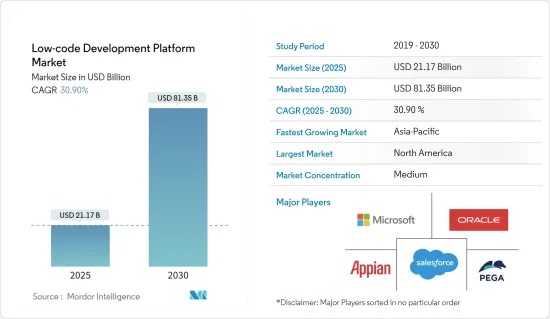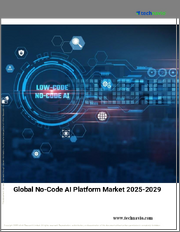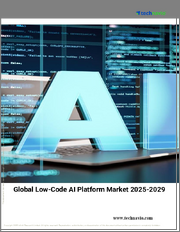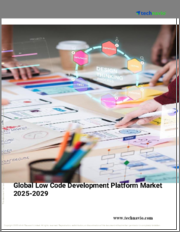
|
시장보고서
상품코드
1690128
로우코드 개발 플랫폼 : 시장 점유율 분석, 산업 동향, 성장 예측(2025-2030년)Low-code Development Platform - Market Share Analysis, Industry Trends & Statistics, Growth Forecasts (2025 - 2030) |
||||||
로우코드 개발 플랫폼 시장 규모는 2025년에 211억 7,000만 달러, 2030년에는 813억 5,000만 달러에 달할 것으로 예측됩니다. 예측 기간 중(2025년-2030년) CAGR은 30.9%를 나타낼 전망입니다.

기업들은 디지털 현대화로 전환하면서 점점 더 낮은 코드의 솔루션을 수용하고 있습니다. 로우코드의 장점은 시간을 절약할 수 있는 드래그 앤 드롭 인터페이스입니다.
로우코드 솔루션은 전통적인 온프레미스 개발의 속도와 유연성을 능가하며 기능적인 솔루션과 통합을 신속하게 만들 수 있는 힘을 조직에 제공합니다. 이전에는 통합에 까다로운 IT 작업이 필요했고 양쪽 맞춤형 개발이 필요했습니다. 소프트웨어 개발에 '사는지, 만들까'라는 접근 방식을 채택하는 조직이 늘어남에 따라 속도와 효율성을 높이기 위해 셀프 서비스와 독자적인 기능을 갖춘 다른 솔루션에 주목을 받고 있습니다. 게다가 로우코드 툴의 벤더 개발 컴포넌트도 보다 우수한 사용자 경험을 제공합니다.
인공지능(AI)은 세계 산업에서 폭넓게 채용되고 있습니다. 그러나 인력 부족과 높은 도입 비용과 같은 장애물은 완전한 통합을 방해합니다. 이를 해결하기 위해, 특히 애플리케이션 및 소프트웨어 개발에서 로우코드 AI가 매우 중요한 개념으로 부상하고 있습니다. 범용성과 이점을 바탕으로 많은 기업들이 이 플랫폼에 투자를 추진하고 있습니다.
로우코드 AI를 활용함으로써 기업은 데이터 분석 강화, 사용자 경험 합리화, 비용 절감, 개발 사이클 단축 등 많은 이점을 얻을 수 있습니다. 이러한 유용성이 높아짐에 따라 로우코드 AI의 채용 급증을 뒷받침하고 시장 성장을 가속하는 태세를 갖추었습니다. 예를 들어, 2023년 10월, Rasa는 제네라티브 AI에 깊이 뿌리를 둔 대화 플랫폼을 발표했습니다. 이 움직임은 AI 어시스턴트 제작 프로세스를 간소화하고 직관적인 사용자 인터페이스를 통해 사용자의 편의성을 우선시했습니다.
다양한 업계의 기업들이 소프트웨어 개발 타임라인을 단축하기 위해 로우코드 개발 플랫폼을 채용하는 경우가 늘어나고 있습니다. APEX 버전 23.1과 22.1에서는 많은 강력하고 실용적인 기능이 도입되었습니다.
또한 저비용으로 프로젝트 개발을 가속화하기 위해 로우 코드 솔루션에 주목하는 기업이 늘어나고 있습니다.
예를 들어 2023년 8월 Workato는 IMDA, 기술 파트너인 SGTech, Hreasily, Stone Forest와 공동으로 싱가포르의 중소기업 1,500개를 지원하기 위해 손을 잡았습니다.
게다가 인플레이션에 의한 비용 상승은 로우코드 플랫폼의 구독이나 관련 서비스의 가격 상승으로 연결되어 비용 의식이 높은 조직에 있어서 매력적이지 않게 됩니다.
로우 코드 개발 플랫폼 시장 동향
정보기술분야가 큰 성장을 이룰 전망
- 비즈니스 수요에 대응하기 위해 소프트웨어 개발 사이클을 단축할 필요성이 IT 부서에 로우코드 플랫폼의 채용을 촉구하여 애플리케이션 개발과 배치를 대폭 가속화하고 있습니다. Mendix에 따르면, 로우 코드의 이용은 최근 몇 년간 일관되게 증가하고 있습니다.
- 로우코드 플랫폼을 통해 IT 팀은 더 많은 용도를 보다 빠르게 개발할 수 있어 전반적인 생산성을 향상시키고 전문 지식이 필요한 복잡한 작업에 집중할 수 있게 되었습니다.
- 2023년 6월 디지털 비즈니스 및 IT 서비스에서 중요한 기업인 NTT 데이터는 Everest Group의 2023년 보고서 “OutSystems PEAK Matrix Assessment에서 로우코드 애플리케이션 개발 서비스의 리더로 평가되었습니다.
- IT기업은 로우코드 개발 플랫폼 시장을 독점하는 데 중요한 역할을 했습니다.
- Caspio의 최근 설문조사는 로우코드 플랫폼 사용자의 63%가 맞춤 앱 수요를 충족하는 데 필요한 기술과 리소스를 보유하고 있음을 보여주었습니다. 커스텀 앱의 납기와 예산 제약을 모두 충족하고 납품에 성공했다고 보고하고 있습니다.
아시아태평양이 최대 시장 점유율을 차지할 전망
- 아시아태평양의 많은 국가에서 금융, 건강 관리 및 소매를 포함한 다양한 업계에서 상당한 디지털 혁신이 진행되고 있습니다. 그리고 이 과정을 가속화하는 데 도움이 됩니다. IBEF에 따르면, 인도는 세계에서 두 번째로 급속하게 디지털 경제가 성장하고 있습니다.
- 이 지역에서는 클라우드 컴퓨팅의 도입이 진행되고 있으며, 그 대부분이 클라우드 네이티브인 로우코드 플랫폼의 성장을 지원하고 있습니다. 클라우드 기반 저코드 플랫폼은 확장성, 유연성, 더 낮은 인프라 비용을 제공합니다. 인도의 퍼블릭 클라우드 서비스(PCS) 시장은 2021년부터 2026년에 걸쳐 CAGR 24%를 나타낼 전망이며, 135억 달러에 이를 것으로 예측되고 있습니다.
- 이 지역은 모바일 애플리케이션의 채용이 증가하고 있기 때문에 예측 기간 동안 크게 성장할 것으로 예상됩니다.
- Huawei, World, Technical Services는 14N 모델로 구성된 GDE(General Digital Engine) 플랫폼을 발표했습니다. 여기서 '1'은 오픈 클라우드 네이티브 플랫폼을 의미하며, '4'는 4가지 주요 기능, 즉 데이터 공유, 지능형 생산 흐름, 능력 공유, 통합된 로우코드 자체 개발을 하이라이트하고 있습니다. 계획부터 건설, 유지보수, 최적화에 이르기까지 운송 회사의 프로세스 전반에 걸쳐 디지털 기술과 스마트 기술을 통합합니다.
- 또한 2023년 11월, OutSystems Japan은 클라우드 네이티브 애플리케이션 개발을 위한 로우코드 솔루션인 OutSystems Developer Cloud를 일본에서 배포했습니다. Cloud는 고성능의 안전한 로우코드 용도 플랫폼을 개발자와 기업 모두에게 제공하도록 설계되어 있습니다.
- 이 지역에서는 로우코드 플랫폼을 포함한 많은 디지털 이니셔티브와 개발이 진행되고 있습니다. Malaysia와의 제휴를 발표했습니다.이 전략적 제휴는 키스 플로우의 이미 번영하고 있는 세계 파트너 네트워크를 확대하는 것을 의도하고 있습니다.
로우 코드 개발 플랫폼 업계 개요
로우코드 개발 플랫폼 시장은 많은 기업이 존재하고 세계적으로 중요한 거버넌스 문제가 있으며, 소규모 공급업체가 누적되어 상당한 시장 점유율을 차지하고 있습니다.
- 2024년 7월 : 설계 및 개발을 가속화하는 도구 및 솔루션을 제공하는 중요한 세계 공급업체인 Infragistics는 클라우드 기반 WYSIWYG 드래그 앤 드롭식 로우코드 도구 "App 빌더의 새로운 기능의 여러 가지를 발표했습니다. 이 도구는 전문 개발자부터 초보자 개발자, 비즈니스 이해 관계자 및 의사 결정자까지 모든 기술 수준의 사람들이 최신 비즈니스 웹 애플리케이션을 신속하게 만들 수 있습니다.
- 2024년 3월 이탈리아의 농업 비즈니스 기업인 Amadori사는 디지털 비즈니스 변혁의 진두 지휘를 위해 Appian을 채용했습니다. Platform을 활용하여 보다 신속하고 유연성이 높아 미래에 대응할 수 있는 기술 인프라를 구축했습니다.
기타 혜택 :
- 엑셀 형식 시장 예측(ME) 시트
- 3개월간의 애널리스트 서포트
목차
제1장 서론
- 조사의 전제조건과 시장 정의
- 조사 범위
제2장 조사 방법
제3장 주요 요약
제4장 시장 인사이트
- 시장 개요
- 업계의 매력도 - Porter's Five Forces 분석
- 공급기업의 협상력
- 소비자의 협상력
- 신규 참가업체의 위협
- 대체품의 위협
- 경쟁 기업간 경쟁 관계의 강도
- 주요 거시 경제 동향이 시장에 미치는 영향
제5장 시장 역학
- 시장 성장 촉진요인
- 신속한 커스터마이징과 확장성에 대한 요구 증가
- 기업 이동성 증가
- 필요한 IT 스킬의 갭 해소
- 시장의 과제
- 벤더 제공의 커스터마이즈에의 의존
제6장 새로운 기술 동향
제7장 시장 세분화
- 용도 유형별
- 웹 기반
- 모바일 기반
- 데스크톱 서버 기반
- 전개 유형별
- 온프레미스
- 클라우드
- 조직 규모별
- 중소기업
- 대기업
- 업계별
- BFSI
- 소매 및 E-Commerce
- 정부 및 방위
- 정보기술
- 에너지 및 유틸리티
- 제조업
- 헬스케어
- 기타 업계별
- 지역별
- 북미
- 유럽
- 아시아태평양
- 라틴아메리카
- 중동 및 아프리카
제8장 경쟁 구도
- 기업 프로파일
- Microsoft Corporation
- Appian Corporation
- Oracle Corporation
- Pegasystems Inc.
- Magic Software Enterprises Ltd
- AgilePoint Inc.
- Outsystems Inc.
- Mendix Inc.
- ZOHO Corporation
- QuickBase Inc.
- Clear Software LLC
- Kony Inc. 8.14 ServiceNow Inc.
- Skuid Inc.
제9장 벤더의 시장 포지셔닝 분석
제10장 투자 분석
제11장 투자 분석 시장의 미래
SHW 25.05.09The Low-code Development Platform Market size is estimated at USD 21.17 billion in 2025, and is expected to reach USD 81.35 billion by 2030, at a CAGR of 30.9% during the forecast period (2025-2030).

Businesses are increasingly embracing low-code solutions as they pivot toward digital modernization. This shift aims to enhance user experiences, streamline processes, and fortify essential systems. The appeal of low-code platforms lies in their cost-effectiveness. The advantage of low code is its drag-and-drop interface, which saves time. In low code, every single process is shown visually with the help of a graphical interface that makes everything easier to understand. It is easier for developers to create their applications.
Low-code solutions empower organizations to create functional solutions and integrations swiftly, outpacing the pace and flexibility of traditional on-premise developments. Previously, integration demanded laborious IT efforts, necessitating custom development on both ends. As more organizations adopt a "buy versus build" approach to software development, they turn to self-service and other solutions with unique functionality to increase speed and efficiency. In addition, the vendor-developed components of low-code tools also offer a better user experience.
Artificial intelligence (AI) is seeing broad adoption in global industries. However, hurdles like talent shortages and high implementation costs hinder its full integration. To address this, low-code AI is rising as a pivotal concept, especially in application and software development. Given its versatility and advantages, many enterprises are channeling investments into this platform.
By harnessing low-code AI, enterprises gain numerous benefits, such as bolstered data analytics, streamlined user experiences, cost savings, and faster development cycles. This heightened utility is fueling a surge in the adoption of low-code AI, poised to propel market growth. For instance, in October 2023, Rasa unveiled a conversational platform deeply rooted in generative AI. This move simplified the AI assistant creation process and prioritized user-friendliness due to its intuitive user interface.
Companies in diverse industries increasingly embrace low-code development platforms to accelerate their software development timelines. For instance, Siemens utilizes Mendix, a significant low-code platform, for developing industrial IoT applications. Also, in January 2024, Oracle announced that the low-code platform continues to enhance its capabilities. The recent Oracle APEX versions 23.1 and 22.1 introduced many potent and practical features.
Furthermore, businesses increasingly turn to low-code solutions to accelerate project development at a reduced cost. Additionally, given their constraints in resources and funds, small and medium-sized enterprises are increasingly gravitating toward instant application development platforms.
For instance, in August 2023, Workato, in collaboration with IMDA and tech partners SGTech, HReasily, and Stone Forest, joined forces to assist 1,500 SMEs in Singapore. Their goal is to streamline and automate workflows. Leveraging Workato's no-code, low-code platform, these SMEs were poised to realize their digital capabilities fully.
Moreover, rising costs due to inflation can lead to increased prices for low-code platform subscriptions and associated services, making them less attractive to cost-conscious organizations. Also, macroeconomic factors affecting global supply chains can lead to delays in hardware procurement and deployment, which can, in turn, slow down the adoption of low-code platforms.
Low-code Development Platform Market Trends
The Information Technology Segment to Witness Significant Growth
- The need for faster software development cycles to keep up with business demands is pushing IT departments to adopt low-code platforms, significantly speeding up application development and deployment. According to Mendix, low-code usage has grown consistently over the past few years. In 2023, about 50% of global coding was done using low code, while in 2024, it is expected to overtake conventional coding to reach 55%.
- Low-code platforms enable IT teams to develop more applications in less time, improving overall productivity and allowing them to focus on more complex tasks that require their expertise. Many organizations use low-code platforms to modernize legacy systems, integrating them with new technologies and extending their functionality without extensive re-coding.
- In June 2023, NTT DATA, a significant player in digital business and IT services, was recognized as a leader by Everest Group in its 2023 report on Low-Code Application Development Services for OutSystems PEAK Matrix Assessment. The assessment analyzed 15 service providers and focused on their strategies, capabilities, vision, and market presence in delivering services on the OutSystems low-code platform.
- IT enterprises played a key role in dominating the low-code development platform market. This is because the firms operating in this vertical need to develop many applications, either for mobile or online (or both), for themselves and their clients. Further, the benefits of low-code development platforms enabled apps to be created, shared, and updated quickly, leading to improved productivity and optimized resource utilization.
- A recent study by Caspio revealed that 63% of low-code platform users possess the necessary skills and resources to meet the demand for custom apps. Additionally, 61% of these users reported successful delivery of custom apps, meeting both deadlines and budget constraints. Moreover, 58% of respondents using low-code platforms expressed confidence in meeting their business's custom app demands.
Asia-Pacific is Expected to Hold the Largest Market Share
- Many countries in Asia-Pacific are undergoing significant digital transformation across various industries, such as finance, healthcare, and retail. Low-code platforms help accelerate this process by enabling faster and more efficient application development. According to IBEF, India has become the world's second-fastest-growing digital economy. The country's digital revolution is expected to be a USD 1 trillion opportunity.
- The increasing adoption of cloud computing in the region supports the growth of low-code platforms, many of which are cloud-native. Cloud-based low-code platforms offer scalability, flexibility, and lower infrastructure costs. The Indian public cloud services (PCS) market is anticipated to reach USD 13.5 billion, registering a compound annual growth rate of 24% between 2021 and 2026. Further, it may propel the growth of the market studied.
- The region is anticipated to grow significantly over the forecast period, owing to the increasing adoption of mobile applications. Asia-Pacific includes many SMEs with limited resources, forcing them to adopt managed services. The governments in the region also adopted a mobile-first strategy to provide better services to their citizens, thereby driving the market.
- Huawei Global Technical Service unveiled its General Digital Engine (GDE) platform, structured around the "1+4+N" model. Here, "1" signifies an open cloud-native platform, while "4" highlights its four key capabilities, i.e., data sharing, intelligent production flow, capability sharing, and integrated low-code self-development. The GDE integrates digital and smart technologies across carriers' processes, from planning and construction to maintenance and optimization. This integration empowers carriers to evolve into digital entities and collaborative partners, fostering innovation across "N" application scenarios.
- Furthermore, in November 2023, OutSystems Japan Co. Ltd rolled out its OutSystems Developer Cloud, a low-code solution tailored for cloud-native application development in Japan. OutSystems Developer Cloud is designed to offer a high-performance, secure, and low-code application platform catering to both developers and enterprises. Its versatility shines as it supports secure deployment in large-scale applications and facilitates end-to-end development from front to back.
- Many digital initiatives and developments, including low-code platforms, are occurring in the region. For instance, in December 2023, the low-code/no-code enterprise platform Kissflow announced a partnership with PointStar Malaysia, a significant cloud transformation firm in Southeast Asia. This strategic collaboration intends to broaden Kissflow's already thriving global partner network. It is expected to offer a modern low-code work platform to aid businesses in digitally transforming their operations.
Low-code Development Platform Industry Overview
The low-code development platform market is moderately fragmented, with the presence of many players, significant governance challenges globally, and smaller vendors cumulatively holding a substantial market share. The market vendors with deep pockets are actively involved in strategic M&A activities, while small companies are involved in product innovation strategies to gain market share.
- July 2024: Infragistics, a significant global provider of tools and solutions to accelerate design and development, announced an array of new features in "App Builder," the essential cloud-based WYSIWYG drag-and-drop low-code tool that enables all skill levels, from professional and novice developers to business stakeholders and decision-makers, to create modern business web applications quickly.
- March 2024: Amadori, an Italian agribusiness company, turned to Appian to spearhead its digital business transformation. By harnessing the Appian Platform, Amadori has constructed a technology infrastructure that is faster, more flexible, and future-ready. Over nearly a decade of collaboration, Amadori has effectively revamped and modernized several business operations, capitalizing on Appian's advanced automation and data fabric features.
Additional Benefits:
- The market estimate (ME) sheet in Excel format
- 3 months of analyst support
TABLE OF CONTENTS
1 INTRODUCTION
- 1.1 Study Assumptions and Market Definition
- 1.2 Scope of the Study
2 RESEARCH METHODOLOGY
3 EXECUTIVE SUMMARY
4 MARKET INSIGHTS
- 4.1 Market Overview
- 4.2 Industry Attractiveness - Porter's Five Forces Analysis
- 4.2.1 Bargaining Power of Suppliers
- 4.2.2 Bargaining Power of Consumers
- 4.2.3 Threat of New Entrants
- 4.2.4 Threat of Substitute Products
- 4.2.5 Intensity of Competitive Rivalry
- 4.3 Impact of Key Macroeconomic Trends on the Market
5 MARKET DYNAMICS
- 5.1 Market Drivers
- 5.1.1 Increasing Need for Rapid Customization and Scalability
- 5.1.2 Increasing Enterprise Mobility
- 5.1.3 Elimination of Gaps in Required IT Skills
- 5.2 Market Challenges
- 5.2.1 Dependency on Vendor-supplied Customization
6 EMERGING TECHNOLOGY TRENDS
7 MARKET SEGMENTATION
- 7.1 By Application Type
- 7.1.1 Web-based
- 7.1.2 Mobile-based
- 7.1.3 Desktop- and Server-based
- 7.2 By Deployment Type
- 7.2.1 On-premise
- 7.2.2 Cloud
- 7.3 By Organization Size
- 7.3.1 Small and Medium Enterprises
- 7.3.2 Large Enterprises
- 7.4 By End-user Vertical
- 7.4.1 BFSI
- 7.4.2 Retail and E-commerce
- 7.4.3 Government and Defense
- 7.4.4 Information Technology
- 7.4.5 Energy and Utilities
- 7.4.6 Manufacturing
- 7.4.7 Healthcare
- 7.4.8 Other End-user Verticals
- 7.5 By Geography
- 7.5.1 North America
- 7.5.2 Europe
- 7.5.3 Asia-Pacific
- 7.5.4 Latin America
- 7.5.5 Middle East and Africa
8 COMPETITIVE LANDSCAPE
- 8.1 Company Profiles
- 8.1.1 Microsoft Corporation
- 8.1.2 Appian Corporation
- 8.1.3 Oracle Corporation
- 8.1.4 Pegasystems Inc.
- 8.1.5 Magic Software Enterprises Ltd
- 8.1.6 AgilePoint Inc.
- 8.1.7 Outsystems Inc.
- 8.1.8 Mendix Inc.
- 8.1.9 ZOHO Corporation
- 8.1.10 QuickBase Inc.
- 8.1.11 Clear Software LLC
- 8.1.12 Kony Inc. 8.14 ServiceNow Inc.
- 8.1.13 Skuid Inc.



















